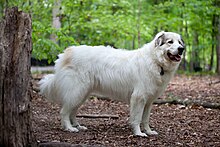Great Pyrenees
 |
||||||||||||||||||||||||||
| Other names | Pyrenean Mountain Dog Patou Montañés del Pirineo Perro de Montaña de los Pirineos Can de Montaña de os Perinés Chien des Pyrénées Chien de Montagne des Pyrénées |
|||||||||||||||||||||||||
|---|---|---|---|---|---|---|---|---|---|---|---|---|---|---|---|---|---|---|---|---|---|---|---|---|---|---|
| Common nicknames | Pyr, GP, PMD | |||||||||||||||||||||||||
| Origin | France/Spain | |||||||||||||||||||||||||
|
||||||||||||||||||||||||||
|
||||||||||||||||||||||||||
| Domestic dog (Canis lupus familiaris) | ||||||||||||||||||||||||||
| Traits | |||
|---|---|---|---|
| Life span | 10 to 11 years | ||
| Classification / standards | |||
|---|---|---|---|
| FCI | Group 2, Section 2.2 Molossian: Mountain type #137 | standard | |
| AKC | Working | standard | |
| ANKC | Group 6 (Utility) | standard | |
| CKC | Group 3 - Working Dogs | standard | |
| KC (UK) | Pastoral | standard | |
| NZKC | Utility | standard | |
| UKC | Guardian Dog | standard | |
The Pyrenean Mountain Dog, known as the Great Pyrenees in North America, is a large breed of dog used as a . It should not be confused with the Pyrenean Mastiff.
As late as 1874 the breed was not completely standardized in appearance, with two major sub-types recorded, the Western and the Eastern. They are related to several other large white European (LGD), including the Italian Maremma Sheepdog, Kuvasz (Hungary), Akbash Dog (Turkey) and Polish Tatra or Polski Owczarek Podhalański, and somewhat less closely to the Newfoundland and St. Bernard. According to the Great Pyrenees Club of America, the Great Pyrenees is naturally nocturnal and aggressive with any predators that may harm its flock. However, the breed can typically be trusted with small, young, and helpless animals of any kind due to its natural guardian instinct.
The Great Pyrenees breed has experienced a dramatic fall off in the number of U.S. AKC breed registrations from 2000 to 2010. The breed was ranked at #45 in 2000 and by 2010 Great Pyrenees had dropped to #71. In 2013 the breed was ranked #69. Other large breeds in the same working group classification, Newfoundland and St. Bernard, have fared far better in maintaining their breed rankings. In 2010 Newfoundland and St. Bernard were ranked #44 and #45 respectively.
They grow to 85–140 pounds (39–64 kg) and 25–32 inches (64–81 cm). On average, their lifespan is 10 to 11 years.
The weather resistant double coat consists of a long, flat, thick, outer coat of coarse hair, straight or slightly undulating, and lying over a dense, fine, woolly undercoat. The coat is more profuse about the neck and shoulders where it forms a ruff or mane, which is more pronounced in males so that it may fend off wolf attacks. The longer hair on the tail forms a plume. There is also feathering along the back of the front legs and along the back of the thighs, giving a "pantaloon" effect. The hair on the face and ears is both shorter and of finer texture.
The main coat color is white and can have varying shades of gray, red (rust), or tan around the face (including a full face mask), ears and sometimes on the body and tail. As Great Pyrenees mature, their coats grow thicker and the longer colored hair of the coat often fades. Sometimes a little light tan or lemon will appear later in life around the ears and face. Being a double-coated breed, the undercoat can also have color and the skin as well. The color of the nose and on the eye rims should be jet black. Grey or tan markings that remain lend the French name, "blaireau", (badger) which is a similar grizzled mixture color seen in the European badger. More recently, any color is correctly termed "Badger" or "Blaireau".
...
Wikipedia
